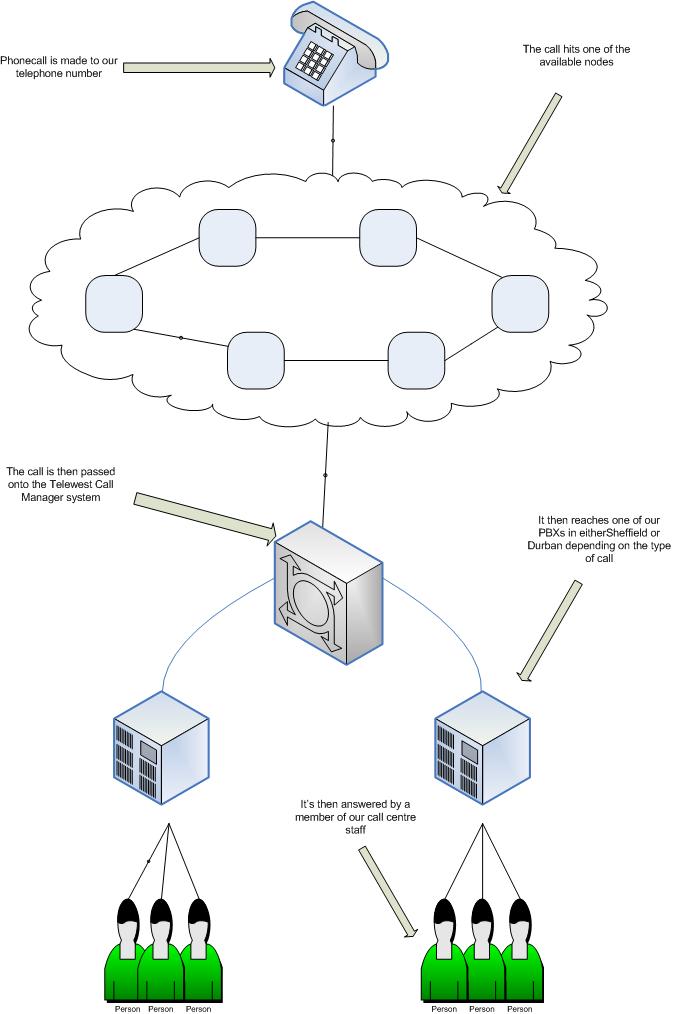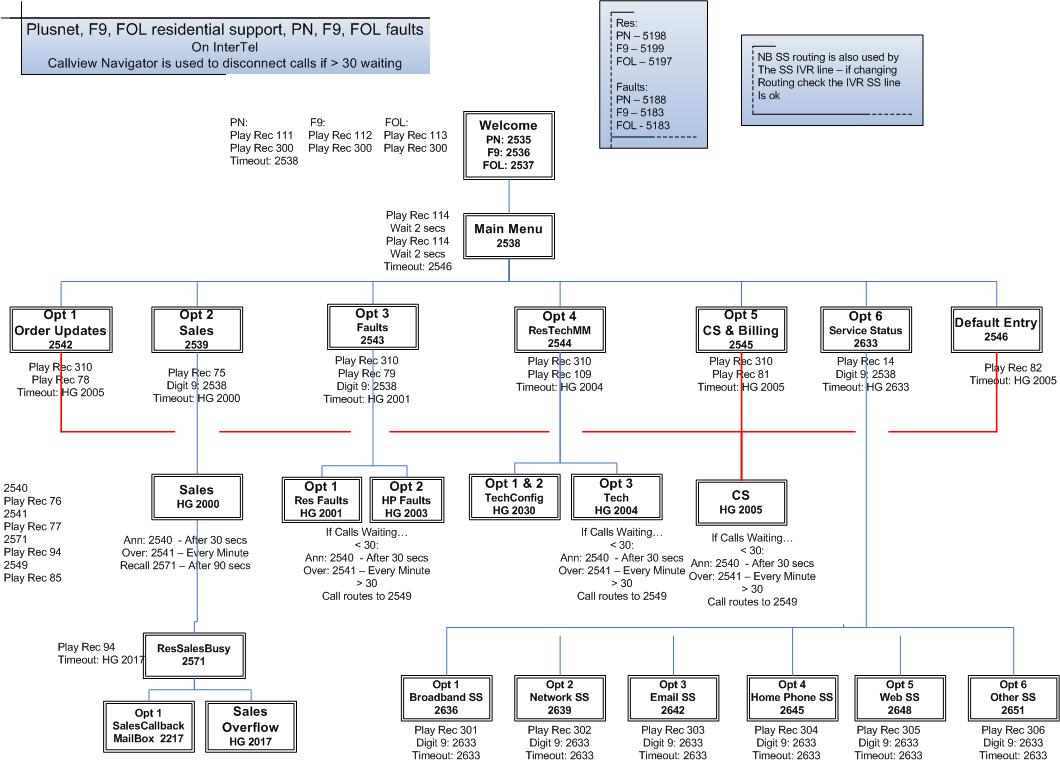We’ve talked recently about moving to a “Network IVR” and we’ve told Force9 and Free-Online customers about a change to our main telephone number. I’d like to spend a bit of time telling you what an IVR actually is, how ours works and the changes we’re going to make. Wikipedia defines an IVR as an “Interactive voice response, which is a technology that allows a computer to detect voice and keypad inputs. IVR systems can respond with pre-recorded or dynamically generated audio to further direct users on how to proceed. IVR systems can be used to control almost any function where the interface can be broken down into a series of simple menu choices. In telecommunications IVR systems generally scale well to handle large call volumes”. More simply put, it’s a system that we and many other companies use to queue incoming phone calls and to pass them through to a member of staff. For us, it allows us to pass a sales call through to a member of our Sales Team or a technical call to be passed to our Technical Support Team, for example. The IVR system that we use is called the InterTel Axxess v.9 PBX. This is essentially a digital switchboard. Currently, when you call us, your call is routed straight through to our PBX (switchboard). From there you’re asked to select an option depending on what your call is about, where it is then passed through to a “Huntgroup” where it is answered accordingly by a member of our call centre staff. All of our non geographic (0845) go through to our geographic (01142) number, which in turn terminates on one of our ISDN lines and is subsequently passed to the PBX. Having a geographic number means that our customers can call us at a cheap, or even free rate, depending on their telephone package. What we are planning to do is to make our system more flexible. When you call us on our 0845 number this call will then be passed through to a relevant PBX by Telewest’s Call Manager system. From there it is passed through to the Huntgroup and the call is answered. The obvious main difference is the addition of the Call Manager system. This gives us the ability to route a call through to a different PBX depending on what type of call it is (such as to send a Madasafish call through to our PBX in Durban or a Plusnet call through to our PBX in Sheffield). It also gives us the ability to break down the proportion of calls to one PBX and send the remainder to another (such as sending 40% of Sales calls to Durban and the remaining 60% to Sheffield). This gives us a fantastic advantage should something unpredictable happen, like in the not so distant past Sheffield Floods. Should something like that happen again, we could choose to send a percentage of calls through to Durban, so that any increase in the amount of time you would need to wait for your calls to be answered would be minimised. Another advantage that this will give us is additional resiliency. There are various Nodes that feed into the Call Manager platform. Should all but one of these Nodes fail, the platform will continue to run, meaning that our customers will still be able to call us, unaware of any such issues. Also, should either of our PBXs fail, the calls would automatically pass through to the other one, meaning that the calls would still be answered. (See the following diagram😞  However, this does present one immediate disadvantage. The Call Manager platform will only allow non-geographic telephone numbers which would mean that we would be unable to keep our 01142 telephone numbers. We are however, looking at implementing non geographic 03xx telephone numbers, which cost the same as calling a geographic one. We will be running our existing system alongside the new one for a time, so that our telephone numbers aren’t just turned off without warning, but we will need to turn them off eventually – no point in paying to use two systems when one is perfectly adequate. We will of course make sure that we give enough notice to all of our customers before doing so. Now we move onto how our own (and current) IVR platform is designed and believe me, it looks a lot more complicated than you might think. (See attached diagram of our Residential IVR😞
However, this does present one immediate disadvantage. The Call Manager platform will only allow non-geographic telephone numbers which would mean that we would be unable to keep our 01142 telephone numbers. We are however, looking at implementing non geographic 03xx telephone numbers, which cost the same as calling a geographic one. We will be running our existing system alongside the new one for a time, so that our telephone numbers aren’t just turned off without warning, but we will need to turn them off eventually – no point in paying to use two systems when one is perfectly adequate. We will of course make sure that we give enough notice to all of our customers before doing so. Now we move onto how our own (and current) IVR platform is designed and believe me, it looks a lot more complicated than you might think. (See attached diagram of our Residential IVR😞  Our IVR works on a system of “Applications” and “Huntgroups”. An application is basically a step in the IVR journey, which contains “messages” and “timeouts”. Whilst the messages are fairly self-explanatory, the timeout passes you through to the next step on the IVR. For example, the “Welcome Application” (the very first step when you phone us) will first play a welcome message (eg: 111 in the attached diagram) followed by a manually entered message (300) if the call wait times are high. Then the timeout happens and you’re passed to the “Menu Application” where you’re asked to select from a number of options. A “Huntgroup” is simply what the call centre agents log into to take the actual calls once they have been passed through to the Huntgroup. They can log into one or many of these depending on the job that they are doing. I’ll give you a couple of examples. The first being pretty simple and the second a little more complex. General Plusnet Customer Service Query - The Welcome application will play messages 111 and potentially 300 before the timeout. - The Menu Application then plays message 114, asking you to choose from a series of Options. - You select Option 5 for Customer Services and Billing and your call is passed through to the correct Extension Application. - You are then played message 310 and 81 at which point your call is transferred to Huntgroup 2005 where a member of our Customer Services Team will answer your call. Plusnet Sales Query (at a busy time) - The Welcome Application will play messages 111 and potentially 300 before the timeout. - The Menu Application then plays message 114, asking you to choose from a series of options. - You’ll then select Option 2 for Sales, where you’re played message 75, which gives you an option to transfer to the main menu, before your call is transferred to Huntgroup 2000. - You’re then passed through to a further Application if the call isn’t answered within 60 seconds, which gives you an option to either leave a message or to wait for your call to be answered. - If you choose the latter, you are then passed to Huntgroup 2017 (Sales Overflow) where your call can be answered by a member of our Customer Services Team. So, I hope that gives you an idea of how things work currently and some of the improvements we’re going to make. I don’t expect you to sit there thinking “Ah, I’m now in the Menu Application” when you’re calling us, but I do hope that this gives you a good understanding of what happens when you’re giving us a ring! James
Our IVR works on a system of “Applications” and “Huntgroups”. An application is basically a step in the IVR journey, which contains “messages” and “timeouts”. Whilst the messages are fairly self-explanatory, the timeout passes you through to the next step on the IVR. For example, the “Welcome Application” (the very first step when you phone us) will first play a welcome message (eg: 111 in the attached diagram) followed by a manually entered message (300) if the call wait times are high. Then the timeout happens and you’re passed to the “Menu Application” where you’re asked to select from a number of options. A “Huntgroup” is simply what the call centre agents log into to take the actual calls once they have been passed through to the Huntgroup. They can log into one or many of these depending on the job that they are doing. I’ll give you a couple of examples. The first being pretty simple and the second a little more complex. General Plusnet Customer Service Query - The Welcome application will play messages 111 and potentially 300 before the timeout. - The Menu Application then plays message 114, asking you to choose from a series of Options. - You select Option 5 for Customer Services and Billing and your call is passed through to the correct Extension Application. - You are then played message 310 and 81 at which point your call is transferred to Huntgroup 2005 where a member of our Customer Services Team will answer your call. Plusnet Sales Query (at a busy time) - The Welcome Application will play messages 111 and potentially 300 before the timeout. - The Menu Application then plays message 114, asking you to choose from a series of options. - You’ll then select Option 2 for Sales, where you’re played message 75, which gives you an option to transfer to the main menu, before your call is transferred to Huntgroup 2000. - You’re then passed through to a further Application if the call isn’t answered within 60 seconds, which gives you an option to either leave a message or to wait for your call to be answered. - If you choose the latter, you are then passed to Huntgroup 2017 (Sales Overflow) where your call can be answered by a member of our Customer Services Team. So, I hope that gives you an idea of how things work currently and some of the improvements we’re going to make. I don’t expect you to sit there thinking “Ah, I’m now in the Menu Application” when you’re calling us, but I do hope that this gives you a good understanding of what happens when you’re giving us a ring! James